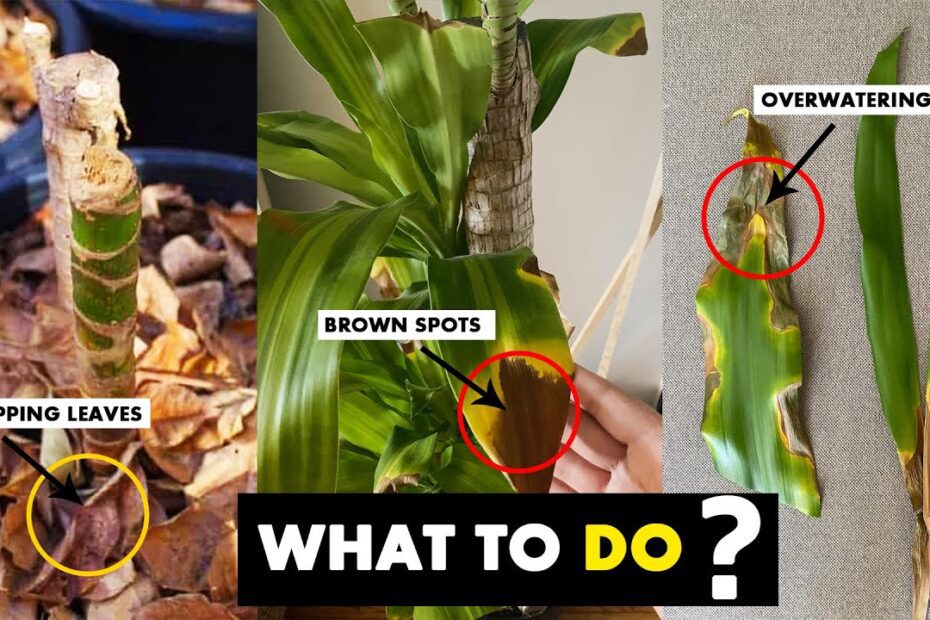The once vibrant emerald leaves of your cherished corn plant are now hanging limp, resembling wilted dreams in need of revival. Fear not, plant enthusiasts! In this captivating guide, we shall delve into the delightful art of resurrection, revealing the secrets to breathe life back into your beloved corn plant. Whether its demise was caused by forgetfulness or a touch of neglect, this article holds the key to breathing new vitality into your green companion. Prepare to embark on a journey where with a little tender care, you will soon witness the triumphant resurgence of your corn plant’s verdant splendor. Dust off your gardening gloves, for it’s time to uncover the bewitching magic that lies within the revival of a corn plant.
Reviving a Corn Plant: A Guide to Breath New Life into Your Green Companion
If you’ve noticed your once-lush corn plant looking a bit droopy and sad, fear not! With a little care and attention, you can breathe new life into your green companion and bring back its vibrant glory. Reviving a corn plant may seem daunting at first, but by following a few simple steps, you’ll soon see your beloved plant thriving once again.
First and foremost, ensure your corn plant is receiving the right amount of light. These plants prefer bright, indirect light, so place them near a window where they can bask in filtered sunlight. Avoid exposing them to direct sunlight, as the intense rays can scorch their leaves. If natural sunlight is limited, consider supplementing with artificial light sources, such as fluorescent or grow lights.
Next, pay close attention to your plant’s watering needs. Overwatering is one of the most common mistakes made when caring for corn plants. They prefer well-draining soil, so allow the top inch of soil to dry out before watering again. When watering, pour water evenly around the plant, making sure to avoid pooling water at the base or in the plant’s crown. In addition, regular misting can help improve humidity levels, as corn plants thrive in moderately humid environments.
Here are some additional features and tips to guide you in reviving your corn plant:
| Features | Tips |
|---|---|
| 1. Pruning: | Remove any yellow or brown leaves to promote new growth. |
| 2. Fertilizing: | Use a balanced houseplant fertilizer once every 2-3 months during the growing season. |
| 3. Repotting: | If your corn plant has outgrown its current pot, gently repot it into a slightly larger container with fresh, well-draining soil. |
By following these care tips and implementing the suggested features, your corn plant will have the best chance at thriving and making a stunning comeback. Remember to be patient and consistent in providing the right conditions, and soon enough, you’ll be delighted by the sight of your once dwindling plant flourishing with renewed vitality.
Understanding the Common Causes of Corn Plant Decline
Corn plants can be a beautiful addition to any garden or indoor space, but sometimes they can experience a decline in their health and vitality. It can be disheartening to see your once thriving corn plant start to wither and struggle. However, is the first step towards reviving it and bringing back its lush green leaves.
One common cause of corn plant decline is overwatering. This can lead to root rot and hinder the plant’s ability to absorb nutrients. To revive your corn plant, make sure to check the moisture level of the soil before watering. Allow the top inch of soil to dry out between waterings and ensure that the pot has proper drainage. Additionally, providing adequate air circulation around the plant can help prevent moisture buildup.
Another cause of corn plant decline is insufficient light. Corn plants thrive in bright, indirect sunlight. Lack of sunlight can cause the leaves to lose their vibrant green color and become dull. To revive your corn plant, consider moving it to a spot with more light or placing it near a window where it can receive at least six hours of bright, indirect sunlight each day. If natural light is limited, you can also supplement with artificial grow lights to provide the necessary light exposure.
| Features | Tips |
|---|---|
| Proper Watering | Check the moisture level of the soil before watering and allow it to dry out partially between waterings. |
| Adequate Sunlight | Place your corn plant in a well-lit area with bright, indirect sunlight or consider using artificial grow lights. |
| Nutrient-rich Soil | Ensure your corn plant is potted in well-draining soil that is rich in organic matter to provide optimal nutrition. |
By and implementing the appropriate solutions, you can revive your beloved plant and restore its beauty. Remember to provide proper watering, adequate sunlight, and nutrient-rich soil for your corn plant to thrive once again. With a little care and attention, your corn plant will soon be back to its healthy and vibrant self.
Essential Steps for Restoring Vitality to Your Wilted Corn Plant
Is your once vibrant and lush corn plant now looking sad and wilted? Don’t worry, we’ve got you covered! Restoring vitality to your corn plant is not as difficult as it may seem. In fact, with a few essential steps, you can bring your wilting corn plant back to life and watch it thrive once again.
First and foremost, ensure that your corn plant receives the right amount of water. Overwatering or underwatering can both lead to wilting. It’s crucial to strike a balance and provide adequate moisture to the plant. Check the soil regularly and only water when the top few inches feel dry. Additionally, make sure the plant is not sitting in excess water by ensuring proper drainage.
| Features | Tips |
|---|---|
| Proper watering | Check soil moisture and provide adequate drainage |
| Sunlight requirements | Place the corn plant in bright, indirect light |
| Temperature range | Maintain a temperature of 65-75°F (18-24°C) |
Another essential factor in reviving your corn plant is providing it with the right amount of sunlight. Corn plants thrive in bright, indirect light. Ensure that it is placed near a window or in a well-lit area of your home. However, direct sunlight can be too harsh and may cause leaf burn, so finding the perfect balance is key.
Effective Care Techniques to Revitalize Your Corn Plant
Has your corn plant been looking a little lackluster lately? Don’t worry, with the right care techniques, you can bring it back to life and have it thriving in no time! Follow these tips and watch your corn plant flourish once again.
1. Adequate Watering:
One of the most crucial aspects of caring for a corn plant is ensuring it receives proper watering. Keep the soil damp, but not waterlogged, as excessive moisture can lead to root rot. During the growing season, watering once a week should suffice, but adjust based on the plant’s needs.
2. Provide Ample Sunlight:
Like most plants, corn plants thrive in bright, indirect sunlight. Place your plant near a window that receives filtered light, or if growing indoors, use a fluorescent grow light. Avoid exposing it to direct sunlight as it can scorch the leaves.
| Features | Tips |
|---|---|
| 1. Correct Temperature | Keep the temperature between 60-75°F (15-24°C) for optimal growth. |
| 2. Occasional Fertilization | Feed your corn plant with a balanced liquid fertilizer once a month during the growing season. |
| 3. Pruning and Cleaning | Remove yellowing or damaged leaves regularly to promote new growth and maintain cleanliness. |
By following these care techniques, you’ll be well on your way to breathing new life into your corn plant. Remember to stay patient and consistent in your approach, as plants require time to respond to changes. With a little TLC, your corn plant will soon be a vibrant and thriving addition to your space!
Frequently Asked Questions
Q: Is my wilting corn plant bringing you down? Need a little pep talk to revive it?
A: Fear not, fellow corn enthusiasts! Get ready for a hearty resurrection of your precious green companion with our article on how to revive a corn plant.
Q: Why is my corn plant withering away despite my best efforts?
A: Ah, the tale of the droopy corn plant! It’s often a result of overwatering or underwatering. Find out the secret behind striking the perfect balance and rescuing your corn plant from its hibernation.
Q: How can I bring life back to my poor, sad corn plant?
A: Just like a magician revealing their trick, we’ll reveal the steps to magically rejuvenate your corn plant. From creating a cozy environment to providing the right nutrition, this article has you covered on how to revive your corn plant and make it flourish once again! And with that, you now hold the secrets to breathe new life into your beloved corn plant. Remember, nature has an extraordinary way of healing and rejuvenating, and your green companion is no exception. As you embark on this journey of revival, let patience be your guide, and attentiveness your faithful companion. Nurture it with care, just as one would tend to a fragile sapling, providing the perfect blend of light, water, and nutrients.
Watch in awe as vibrant shoots emerge from barren earth, reaching towards the heavens with insatiable thirst for growth. Witness the magnificent transformation as faded foliage is replaced by a resplendent canopy of green, stood tall with collective might. Marvel at the symphony of life that unfolds within the lush tapestry of your rejuvenated corn plant.
In this age of concrete walls and digital landscapes, embracing the natural world within the comfort of our homes brings solace and harmony. So as you witness your corn plant flourish under your skilled guardianship, let it serve as a gentle reminder of the beauty and resilience that Mother Nature gifts us.
And perhaps, as your corn plant thrives, you’ll find yourself more attuned to the subtle dance of the seasons, more appreciative of the gentle whispers carried upon the wind. For in cultivating the growth of your corn plant, you too have nurtured a shimmering thread that connects you to the wider tapestry of life.
So go forth now, armed with the knowledge to revive and invigorate your corn plant. Allow your hands to become an extension of nature itself, rejoicing in the wondrous journey of renewal and transformation. And amidst the humble green leaves of your restored plant, find solace, find joy, find the rhythm of life itself.
- When to Put Weed and Feed on Lawn in Michigan - October 16, 2023
- When to Fertilize Potatoes Plants - October 16, 2023
- Can You Plant Clover in the Spring - October 16, 2023




